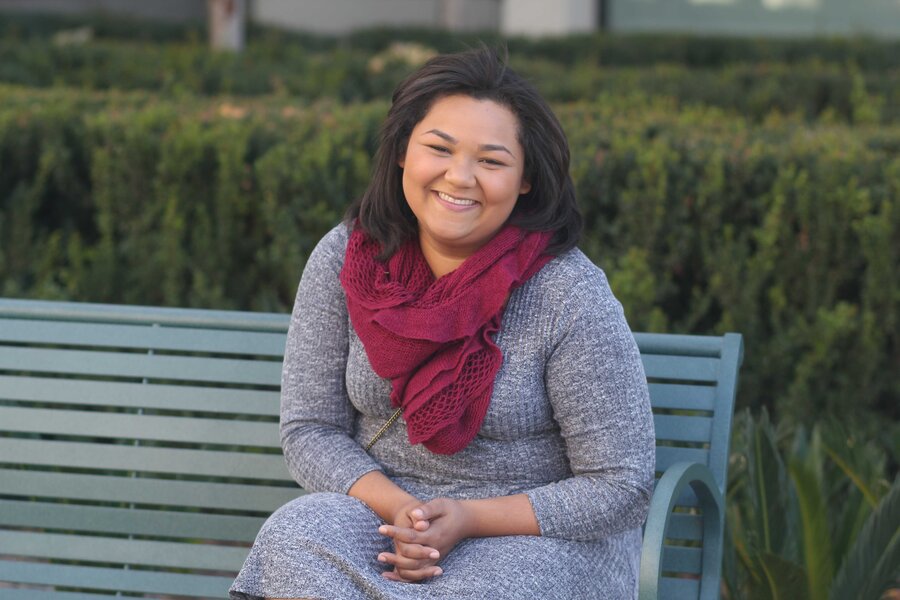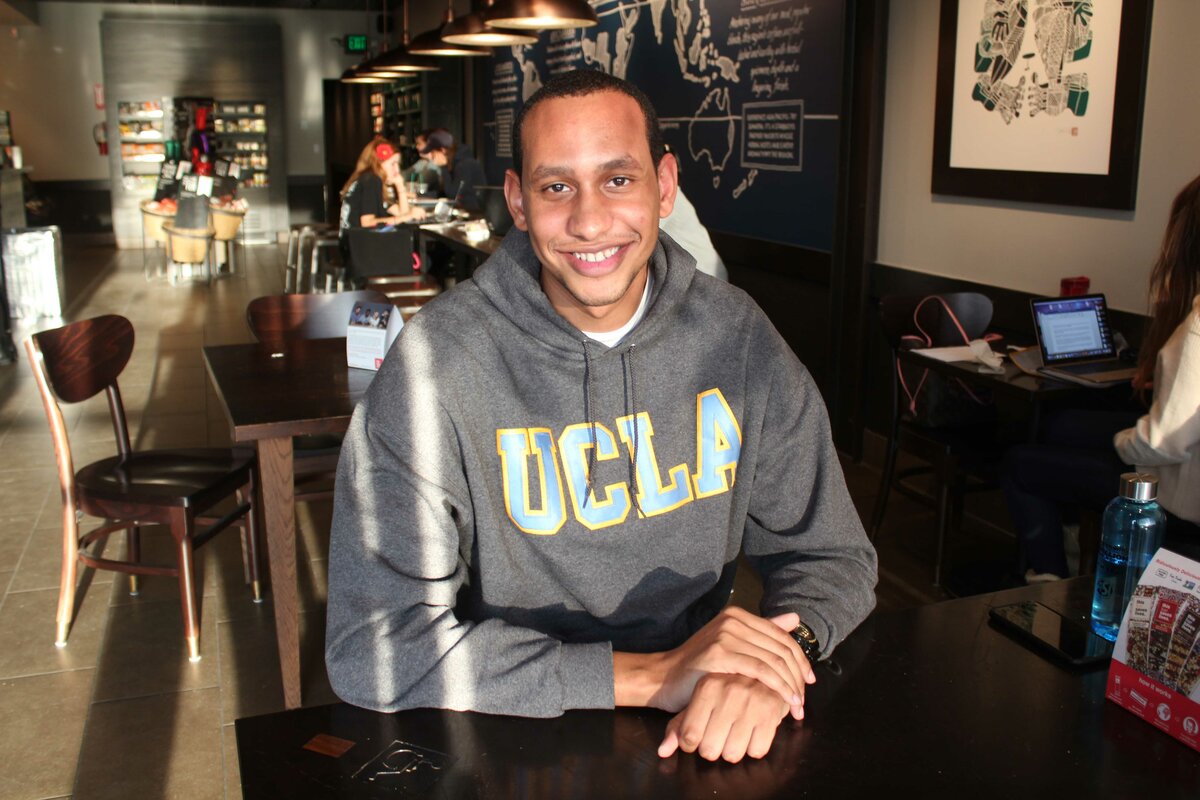For middle-income college students, a rising dilemma
Loading...
| Fullerton, Calif.
When it came to paying for college, Kelsey Brewer tried to do everything right.
She worked two jobs. She took out loans. She filled out the free application for federal student aid, or FAFSA, every year – a step that students who hail from middle-income families, as Ms. Brewer does, tend to skip because they assume they won’t qualify for financial aid.
But money was tight. When funds were lowest – usually around the end of the semester – Brewer had to make tough choices. One of the toughest: Whether she could afford to eat that day.
“There were times that I just went without,” says Brewer, who graduated in May from California State University, Fullerton, with a political science degree. “I was not eating every day. You have to decide: ‘Do I go to the grocery store or pay my internet bill today?’ ”
Brewer’s experience illustrates the financial challenges increasingly facing students – even middle-income students attending public institutions – as the cost of college attendance soars.
Years of state divestment in public higher education, among other factors, have placed greater financial burdens than ever on students and families, education experts say. Even when students manage to secure aid for tuition, food, housing, transportation, and school supplies can combine to make money a constant concern.
It’s a well-documented problem that some states are beginning to grapple with. Even as it continues to raise tuition, California is also offering new scholarships for middle-class students.
It’s just a drop – and experts say students will continue to bear rising costs. But it’s an issue that could take on new significance on the eve of Donald Trump’s presidency.
With issues such as immigration and health care expected to be top priorities for his administration, some worry that higher education will take a backseat – or pivot in a direction that threatens opportunity for millions of students relying heavily on federal support for their education.
“He had a relatively understated or unarticulated higher-education agenda during his campaign,” says Bob Giannino, chief executive officer for uAspire, a national nonprofit that provides college affordability services. “There’s an opaqueness to the direction and focus of President-elect Trump around higher education, so that we’re sitting on the edge.”
“Some folks think that’s a good thing. Like, ‘He’s not going after higher ed,’ ” Brewer adds. “ I think a lack of attention is just as bad as over-attention.”
Need for degree, and price, going up
Since even before the Great Recession, Americans have grappled with the reality that the exponential rise in the cost of college comes at a time when a degree is increasingly vital to career success.
Three quarters of the fastest-growing jobs today require postsecondary training or education. At the same time, the cost of attendance at public institutions rose 42 percent between 1996 and 2012, largely because of increases in living expenses, transportation, school supplies, and other costs, according to research by Sara Goldrick-Rab, a professor of higher education policy and sociology at Temple University in Philadelphia and author of the 2016 book, “Paying the Price.” Since 2004, in some states, like California, tuition and fees have more than doubled.
Such a challenge with such high stakes requires a big commitment from leadership at both the state and national levels, some say.
“We have a society that’s drifted toward viewing college as an individual benefit, and so the individual has to pay for it,” says Jerry Lucido, executive director of the Center for Enrollment Research, Policy, and Practice at the University of Southern California.
But as the economy as a whole grows to rely on jobs that need more than a high school diploma, he says, “We need stronger messages that college is both financially feasible and worth the time and money.” Government strengthens that message by directing dollars toward public institutions and students themselves, he says.
How Mr. Trump aims to approach higher education remains unclear, though some of what he has said has left some educators and students fretting about the future.
In May, for instance, the Trump campaign suggested that the new administration would work to scale back federal government’s role in student lending and hand the function back to private companies. Supporters say a market-driven approach could be more accurate in determining a student’s capacity to repay loans and reduce the number of students who borrow too much.
Others fear such a move would make college more inaccessible. Private companies tend to charge higher interest rates than the federal government, which also allows the poorest students to hold off paying interest on their loans until after they graduate. In the 2015-2016 academic year, 32 percent of all US undergraduates took out some form of loan from the federal government.
Brewer, for one, says she would never have been able to get her degree without federal loans to cover her tuition. In her junior year, she worked 40 hours a week in addition to going to class full time. Even then, Brewer says, there wasn’t always money for groceries.
“We’d all go McDonald’s and order as much as we could off the dollar menu since we knew we weren’t going to get to eat again [that day],” she says.
Today, Brewer has about $26,000 in student loans – less than the national average of $30,100 – and says she’s grateful they’re from the federal government.
Devon Graves also relied largely on federal loans to pay for his education at California State Polytechnic University in Pomona. Like Brewer, he says it was hard enough to finance college knowing the federal government had higher education issues and college students top-of-mind.
“It's not great to have loans, but there’s a lot more protections that are guaranteed,” says Mr. Graves, now pursuing a doctorate in higher education at the University of California, Los Angeles. “Knowing that the federal government invested that bit is a little more reassuring.”
“With the election of Donald Trump, we just don’t know what higher education is going to look like,” he continues. “I think we’re going to see a huge shift.”
Help for the middle class
With the Trump administration’s higher education agenda still in question, eyes are on efforts by states and institutions to help low- and middle-income students and families. In California, home to the nation’s largest public higher education system, the state Student Aid Commission launched in 2014 the Middle Class Scholarship, meant to provide support to students whose families make up to $154,000 a year.
Lawmakers also reached a deal this year to increase funding starting next May for both the California State University and University of California systems – on the condition that they enroll more state residents and cap nonresident enrollment.
But critics point out those moves come as the UC and Cal State systems mull a tuition hike for the first time in six years to close a budget gap that university leaders say is a result of years of state disinvestment and rising costs.
Still, others say such steps forward matter. Graves, who received about $300 through the Middle Class Scholarship his senior year, says, “it was such a huge symbol of the state investing in middle-class, not only students, but families.” Though the award was small, he says, “it shows that they care about all those students who have unmet need.”
Universities have also stepped up efforts to support students. In November, UC Riverside received recognition for its efforts to close the graduation gap among students of varying socioeconomic backgrounds. The school has over the years worked to expand work-study opportunities, provide free transportation, and offer mentor support for low-income students – all with the goal of achieving graduation parity.
Researchers at the Cal State campuses at Humboldt and Long Beach this year also launched a comprehensive study of food and housing security among the system’s more than 400,000 students. Their findings – that 1 in 10 Cal State students is homeless and one in five doesn’t have regular access to food – revealed a need for a systematic approach to the issue.
Brewer says her own experience has moved her to advocate for greater federal, state, and institutional support for students, especially those from low- and middle-income families. Yet students need to recognize their role in determining their own futures, she says – in the Trump era and beyond.
“Look for scholarships. Use other people’s money when you can. Be very, very diligent,” says Brewer, who has since August been working as a policy analyst for the Association of California Cities – a position she says she could never have come by without a degree.
She hopes to see from students “an acknowledgement of how much power they have. They are the future of the economy and that comes with some weight.”







